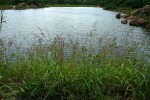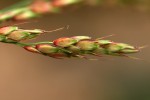| Home | > | List of families | > | Poaceae | > | Sorghum | > | arundinaceum |
Sorghum arundinaceum
Selected images: Click on each image to see a larger version and details of the record View all images (3)
Detailed records: Display species records QDS maps by: Google Maps Point records by Google Maps
Species details: Click on each item to see an explanation of that item (Note: opens a new window)
| Synonyms: |
Andropogon arundinaceus Willd. Andropogon sorghum (L.) Brot. Andropogon sorghum subsp. effusus (Hack.) Piper Andropogon sorghum var. effusus Hack. Andropogon stapfii Hook. f. Andropogon verticilliflorum Steud. Rhaphis arundinacea Desv. Sorghum bicolor (L.) Moench subsp. arundinaceum (Desv.) deWet & Harlan Sorghum halepense sensu Simon, non (L.) Pers. Sorghum pugionifolium Snowden Sorghum stapfii (Hook.f.) C.E.C. Fisch. Sorghum sudanense sensu Hall-Martin & Drummond, non (Piper) Stapf. Sorghum verticilliflorum (Steud.) Stapf |
| Common names: | Black Sudan grass (English) Lebele (Setswana) Molemogale (Setswana) Ntshwe-yabadisa (Setswana) Wild Sorghum (English) |
| Frequency: | |
| Status: | |
| Description: |
Annual, rarely short-lived perennial; culms 30–400 cm high, robust, branched; nodes mostly glabrous, sometimes pubescent; leaf sheaths glabrous; ligule a membrane, edged with a fringe of fine hairs and hairy on the back; leaf laminas variable, often large, 5–75 cm × 5–7 mm, broadly lanceolate, flat, glabrous on both surfaces, with a prominent whitish midrib. Panicle 10–60 cm long, broadly spreading; main axis angular, glabrous; primary branches divided, pubescent at the nodes; racemes 2–7-jointed; rhachis internodes and pedicels pilose. Sessile spikelet (4)7(9) mm long, lanceolate to narrowly ovate; glumes coriaceous; inferior glume dorsally compressed, narrowly ovate, 2-keeled on the margins, the keels winged, the wings not or scarcely broadened above and ending in minute teeth well below the glume apex, the latter not equally 3-toothed, white-pubescent, sometimes tomentose or fulvously pubescent, slightly depressed longitudinally on the back; superior glume glabrescent or with sparse hairs on the back; inferior floret empty, its lemma c. 5.5 mm long, lanceolate, ciliate on the margins; superior floret bisexual, its lemma c. 3 mm long, deeply lobed, ciliate on the lobes and margins, awned; awn up to 20 mm long, glabrous; palea c. 2 mm long. Pedicelled spikelets neuter, c. 6.5 mm long, linear to lanceolate; glumes chartaceous; inferior glume glabrous; superior glume slightly shorter than the inferior, glabrous; inferior lemma glabrous, with a truncate apex. |
| Type location: |
|
| Notes: | |
| Derivation of specific name: | |
| Habitat: | Swampy soils, streamsides, disturbed places and old farmland |
| Altitude range: (metres) | 50 - 1400 m |
| Flowering time: | |
| Worldwide distribution: | Throughout Africa, extending eastwards to Australia |
| National distribution: | N,SE |
| Growth form(s): | |
| Endemic status: | |
| Red data list status: | |
| Insects associated with this species: | Gnophodes betsimena diversa (Larval foodplant) |
| Spot characters: | Display spot characters for this species |
| Literature: |
Chapano, C. & Mamuto, M. (2003). Plants of the Chimanimani District National Herbarium and Botanic Garden, Zimbabwe Page 52. Cope, T.A. (2002). Poaceae Flora Zambesiaca 10(4) Pages 23 - 25. (Includes a picture). Jackson, G. & Wiehe, P.O. (1958). An Annotated Check List of Nyasaland Grasses The Government Printer, Zomba, Nyasaland Page 60. As Sorghum verticilliflorum Mapaura, A. & Timberlake, J. (eds) (2004). A checklist of Zimbabwean vascular plants Southern African Botanical Diversity Network Report No. 33 Sabonet, Pretoria and Harare Page 110. Roodt, V. (2015). Grasses & Grazers of Botswana and the surrounding savanna Struik Nature, South Africa Pages 188 - 189. As Sorghum bicolor subsp. arundinaceum (Includes a picture). Setshogo, M.P. (2000). Notes on the grass subtribe Sorghinae (Poaceae: Andropogoneae) in the Flora Zambesiaca area Kirkia 17(2) Page 139. Setshogo, M.P. (2005). Preliminary checklist of the plants of Botswana. Sabonet Report no. 37. Sabonet, Pretoria and Gaborone Page 145. |
Other sources of information about Sorghum arundinaceum:
Our websites:
Flora of Burundi: Sorghum arundinaceumFlora of Caprivi: Sorghum arundinaceum
Flora of Malawi: Sorghum arundinaceum
Flora of Mozambique: Sorghum arundinaceum
Flora of Zambia: Sorghum arundinaceum
Flora of Zimbabwe: Sorghum arundinaceum
External websites:
African Plants: A Photo Guide (Senckenberg): Sorghum arundinaceumAfrican Plant Database: Sorghum arundinaceum
BHL (Biodiversity Heritage Library): Sorghum arundinaceum
EOL (Encyclopedia of Life): Sorghum arundinaceum
GBIF (Global Biodiversity Information Facility): Sorghum arundinaceum
Google: Web - Images - Scholar
iNaturalist: Sorghum arundinaceum
IPNI (International Plant Names Index): Sorghum arundinaceum
JSTOR Plant Science: Sorghum arundinaceum
Mansfeld World Database of Agricultural and Horticultural Crops: Sorghum arundinaceum
Plants of the World Online: Sorghum arundinaceum
Tropicos: Sorghum arundinaceum
Wikipedia: Sorghum arundinaceum
| Home | > | List of families | > | Poaceae | > | Sorghum | > | arundinaceum |


